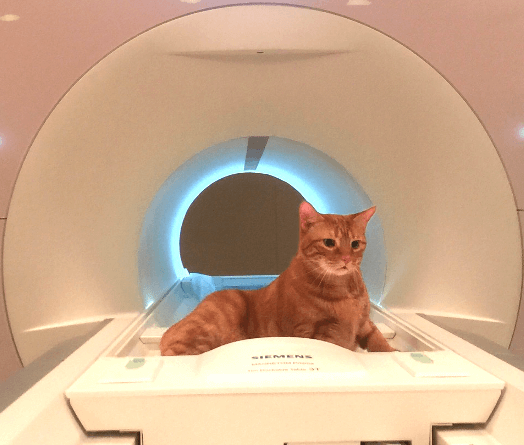Procedures at the Center for Image-Guided Animal Therapy

The Center for Image-Guided Animal Therapy (CIGAT), located at the Johns Hopkins University School of Medicine in Baltimore, Maryland, focuses on bringing cutting-edge minimally invasive diagnostics and procedures to the veterinary pet population. A one-of-a-kind resource for pets and their owners, CIGAT encourages collaborations and cooperation between veterinarians, surgeons, radiologists, physicists, computer scientists, biomedical engineers, chemists, imaging technologists and veterinary technicians to deliver the safest and most effective results in a minimally-invasive form.
Diagnostic Imaging
Computed tomography (CT) and Magnetic Resonance Imaging (MRI) are routine diagnostic imaging procedures performed in pets to determine musculoskeletal problems, such as torn ligaments, broken bones, or tumors, neurological problems, such as seizures or paralysis, and mass or metastatic disease evaluation in cancer. All imaging is done in collaboration with your referring veterinarian to determine the most appropriate procedure for your pet. Speak with a CIGAT veterinarian regarding a specific imaging procedure for your pet
Image-Guided Biopsy
Image-guided biopsy is a method used to obtain tissue samples from areas of the body that are difficult to reach, for example, bone tissue, tissue near the heart or in the lungs, tissue in the brain or near the spinal cord, etc. A veterinarian may use MRI, CT, ultrasound or a combination of these imaging modalities, depending on the specific disease process and which technique is most appropriate. All tissue specimens are delivered to a veterinary laboratory specialized in analyzing the type of tissue obtained. Image-guided biopsy is a minimally-invasive procedure resulting in little to no side effects to the veterinary patient and can often be performed as an out-patient procedures. Speak with a CIGAT veterinarian regarding specific questions for an individual pet.
Cryoablation
Cryoablation is an alternative technique that is used for cancer treatment. Using small needles or rods placed under image guidance, extreme cold can be targeted to cancer cells to kill them by alternating periods of freezing and thawing. Cryoablation is often used to treat nasal tumors, kidney tumors, and bone tumors. Cryoablation is painless, but it is performed under general anesthesia to prevent movement in pets. For many pets, cryoablation can be performed as an outpatient procedure, and your pet can go home the same or next day. Cryoablation can be used as a palliative treatment for cancers when surgical removal is not an option. Talk to a CIGAT veterinarian about specific questions for an individual pet.
Embolization
Embolization is a procedure where particles called “embolics” are typically injected directly into the blood supply feeding a mass. The vessels feeding a mass are accessed by feeding a small tube from a small puncture in the groin under X-ray guidance. Embolics can be combined with chemotherapy to limit toxicity of the chemotherapy and more effectively kill tumor cells. Embolic therapy is often used to treat liver tumors, but experimental treatments for lung tumors are currently being developed at CIGAT. Talk to a CIGAT veterinarian about whether this therapy might be effective in your pet.
Y-90 Radiotherapy
Y-90 radiotherapy delivers radiation in the form of glass beads labeled with Yttrium-90 to a dog’s tumor using the blood vessels supplying the tumor. The radiation only travels a small distance so that a high dose of radiation similar to external beam radiation is delivered to the tumor, but not the surrounding tissue. Thus, the therapy is safe for people spending time with a pet after treatment, but does not require multiple repeat episodes of general anesthesia as is needed for radiation therapy. Y-90 radiotherapy is available to treat liver and brain tumors. Talk to a CIGAT veterinarian about whether this therapy might be effective in your pet.
Radiation Therapy
Intensity-modulated radiation therapy (IMRT) is an advanced mode of precisely delivering radiation therapy to many types of cancer. The goal is to target the cancer without affecting adjacent normal tissue. Because your pet must not move during treatment, it is performed under general anesthesia. Typically the radiation dose is divided up into several doses called “fractions.” Each treatment last approximately five minutes or less. An MRI, CT, or both may be needed to plan radiation treatment. IMRT at CIGAT uses state-of-the-art linear accelerators at Johns Hopkins. Currently, we are offering IMRT for treating brain tumors. Talk to a CIGAT veterinarian about whether this therapy might be effective in your pet.
To learn more about CIGAT
Email: [email protected] | Telephone: 410-502-7325 | Fax 410-614-1977.
